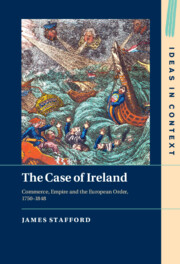Book contents
- The Case of Ireland
- Ideas in Context
- The Case of Ireland
- Copyright page
- Dedication
- Contents
- Acknowledgements
- Introduction
- Chapter 1 The Enlightenment Critique of Empire in Ireland, c. 1750–1776
- Chapter 2 Commerce without Empire?
- Chapter 3 Property, Revolution and Peace, 1789–1803
- Chapter 4 Enlightenment against Revolution
- Chapter 5 The Granary of Great Britain
- Chapter 6 Democracy, Nationality and the Social Question, 1815–1848
- Conclusion
- Bibliography
- Index
Chapter 3 - Property, Revolution and Peace, 1789–1803
Published online by Cambridge University Press: 27 January 2022
- The Case of Ireland
- Ideas in Context
- The Case of Ireland
- Copyright page
- Dedication
- Contents
- Acknowledgements
- Introduction
- Chapter 1 The Enlightenment Critique of Empire in Ireland, c. 1750–1776
- Chapter 2 Commerce without Empire?
- Chapter 3 Property, Revolution and Peace, 1789–1803
- Chapter 4 Enlightenment against Revolution
- Chapter 5 The Granary of Great Britain
- Chapter 6 Democracy, Nationality and the Social Question, 1815–1848
- Conclusion
- Bibliography
- Index
Summary
Chapter 3 explores the consequences of the French Revolution's transformation of European politics through an Irish lens, linking the political thought of key Irish radicals to the emerging propaganda war between the rival empires of Britain and France. For Wolfe Tone and Arthur O’Connor, two key United Irish emissaries to France, French intervention in Irish politics presented an opportunity dismantle the Irish Kingdom’s sectarian property order and replace it with the peasant proprietorship being spread by French arms in the Low Countries, the Rhineland and northern Italy. Ireland’s poverty and instability was meanwhile held by a range of French and German observers to be a clear demonstration of the injustice and weakness of the British Empire, and the superiority of the French alternative. Following their defeat in 1798, key United Irish figures including O’Connor and William James MacNeven mounted powerful defences of Napoleonic empire. At least as far as its leaders were concerned, the 1798 rebellion was borne not of a radical repudiation of empire, but of an embrace of a French over a British variant.
Keywords
- Type
- Chapter
- Information
- The Case of IrelandCommerce, Empire and the European Order, 1750–1848, pp. 100 - 138Publisher: Cambridge University PressPrint publication year: 2022

